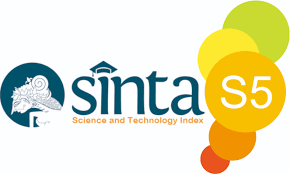Emotional Text Detection dengan Long Short Term Memory (LSTM)
Abstract
Emotional Text Detection is a technique in natural language processing that aims to identify the emotions contained in conversations or text messages. The LSTM (Long Short-Term Memory) method is one of the techniques used in natural language processing to model and predict sequential data. In this study, we propose the use of the LSTM method for emotion detection in conversation. The dataset used is a conversational dataset that contains positive, negative, and neutral emotions. We process datasets using data pre-processing techniques such as tokenization, data cleansing and one-hot encoding. Then, we train the LSTM model on the processed dataset and obtain evaluation results using accuracy metrics. The experimental results show that the LSTM model can be used to detect emotions in conversation with a good degree of accuracy. In addition, we also conducted an analysis on the prediction results of the model and showed that the LSTM model can correctly identify emotions. In conclusion, the LSTM method can be used to detect emotions in conversation with a good degree of accuracy. This method can be used to improve user experience in chat applications and increase the effectiveness of human and machine interactions.
Keywords
Full Text:
PDFReferences
Akhmad Fadjeri, Hidayat, K., & Dwi Riska Handayani. (2021). EMOTION DETECTION ON TEXT USING NAVE BAYES ALGORITHM. JURISTIK (Jurnal Riset Teknologi Informasi Dan Komputer), 1(02), 1-4.
https://doi.org/10.53863/juristik.v1i02.365
W. Parrot, “Emotions in Social Psychology,” in Emotions in Social Psychology, Psychology Press, 2001.
Rona Nisa Sofia Amriza, & Didi Supriyadi. (2021). Komparasi Metode Machine Learning dan Deep Learning untuk Deteksi Emosi pada Text di Sosial Media. JUPITER (Jurnal Penelitian Ilmu Dan Teknik Komputer), 13(2), 130–139.
https://doi.org/10.5281/3603.jupiter.2021.10
Chatterjee, A., Narahari, K. N., Joshi, M., & Agrawal, P. (2019). SemEval-2019 Task 3: EmoContext Contextual Emotion Detection in Text. 39–48.
https://doi.org/10.18653/v1/s19-2005.
Fera Fanesya, Randy Cahya Wihandika, I. (2019). Deteksi Emosi pada Twitter Menggunakan Metode Naive Bayes dan Kombinasi Fitur. Jurnal Pengembangan Teknologi Informasi Dan Ilmu Komputer, 3(7), 3.
“Emotion dataset for NLP”
https://www.kaggle.com/datasets/praveengovi/emotions-dataset-for-nlp?select=test.txt
Harjanta, Aris Tri Jaka. (2015). Preprocessing Text untuk Meminimalisir Kata yang Tidak Berarti dalam Proses Text Mining. Jurnal Informatika Upgris, 1(6).
A.Rajaraman, J.D.Ullman, "DataMining," Mining of Massive Datasets, pp. 1–17, 2011.
Purba, Meytry Petronella, & Yuliagnis Transver Wijaya. (2022). Analisis Basic Emotion Masyarakat Pada Masa Pandemi COVID-19 di Media Sosial Twitter Dengan Metode LSTM-FastText. Seminar Nasional Official Statistics, 1(1), 643-654.
https://doi.org/10.34123/semnasoffstat.v2022i1.1524
“Emotion Classification(NLP)” https://www.kaggle.com/code/dorgavra/emotion-classification-nlp
DOI: http://dx.doi.org/10.22441/format.2023.v12.i2.009
Refbacks
- There are currently no refbacks.
Copyright (c) 2023 Format : Jurnal Ilmiah Teknik Informatika

This work is licensed under a Creative Commons Attribution-NonCommercial-NoDerivatives 4.0 International License.
Format : Jurnal Ilmiah Teknik Informatika
Fakultas Ilmu Komputer Universitas Mercu Buana
Jl. Raya Meruya Selatan, Kembangan, Jakarta 11650
Tlp./Fax: +62215840816
http://publikasi.mercubuana.ac.id/index.php/format

|

Ciptaan disebarluaskan di bawah Lisensi Creative Commons Atribusi-NonKomersial 4.0 Internasional.











